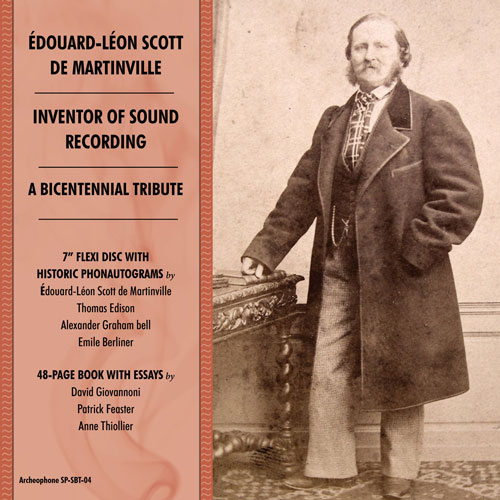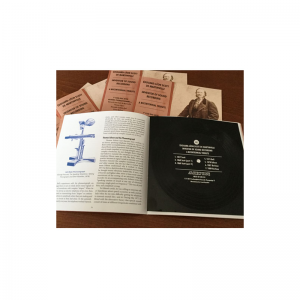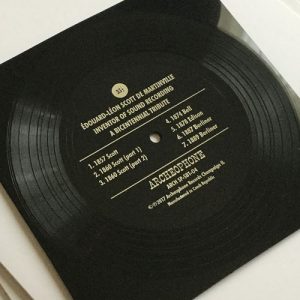

Edouard-Léon Scott de Martinville (1817–1879) invented sound recording twenty years before Thomas Edison re-invented it. But his phonautograph is only one of his many accomplishments. Here, at the bicentennial of his birth, his story is published in depth. This extensively illustrated 48-page softcover book presents new research on Scott and his role as the father of sound recording. Included is a 33-1/3 flexi disc with phonautograms not only by Scott, but also by famous inventors who were inspired by him and his invention: Alexander Graham Bell, Thomas Edison and Emile Berliner. List price: $22.00
OVERVIEW
- Catalogue number: ARCH SP-SBT-04
- UPC: 868490000234
- ISBN: 9780997435917
- Original release date: May 2, 2017
- Running length: nearly 6 minutes / 7 tracks / 7-inch flexi disc
- Notes & packaging: Packaged in a 48-page full-color 7 1/4 ” by 7 1/4″ softcover book
- Includes a link to stream or download the audio
- Tracks recorded: 1857-1889
- In Archeophone’s Special Products series
- Awards: 60th GRAMMY Nominee, Best Album Notes
| Flexi disc tracklist | |
|---|---|
| 1. | The 1857 Phonautograms by Edouard-Léon Scott de Martinville – Diapason donnant 512 vibrations par seconde – Un son de voix grave tenu dans le voisinage de la membrane – Timbre du cornet à piston |
| 2. | The 1860 Phonautograms by Edouard-Léon Scott de Martinville (pt 1) – S’il faut qu’à ce rival; Othello, Act 4, Scene 2 – Epellation du mot rira – Le jour n’est pas plus pur que le fond de mon coeur; Phèdre, Act 4, Scene 2 – Au clair de la lune |
| 3. | The 1860 Phonautograms by Edouard-Léon Scott de Martinville (pt 2) – Gamme de la voix – Chi crederia che sotto forme umane; Aminta – Et incarnatus est de Chérubini; Missa Solemnis in D minor – Vole, petite abeille; “La Chanson de l’Abeille,” La reine Topaze |
| 4. | The 1874 Phonautograms by Alexander Graham Bell
– Five vowel snippets from a photographic print at Library of Congress |
| 5. | The 1878 Phonautograms by Thomas Edison – Train Sounds – Vocalizations |
| 6. | The 1887 Phonautograms by Emile Berliner – Snippets of Vowels – Recitation |
| 7. | The 1889 Phonautograms by Emile Berliner – Counting (1 to 20), Reiters Morgenlied |
Edouard-Léon Scott de Martinville (1817–1879) invented sound recording twenty years before Thomas Edison re-invented it. But his phonautograph is only one of his many accomplishments. Here the partners of First Sounds—the team that played back an 1860 recording of “Au Clair de la Lune” in 2008 and brought Scott’s achievement to the attention of the world—tell his story in depth.
David Giovannoni recounts Scott’s invention and development of sound recording; Patrick Feaster details Scott’s role as the father of sound technology; and noted French author Anne Thiollier offers the first modern biography of Scott, based on family papers. All three essays celebrate Scott’s scientific and literary achievements at the bicentennial of his birth.
The 48 page, 7 1/4 square booklet includes previously unpublished photos of Scott and rare illustrations of early recording technology. The enclosed 33-1/3 rpm flexi disc presents several of Scott’s recordings made in 1857 and 1860. Also featured are some of the earliest recordings made in the U.S. by Alexander Graham Bell, Thomas Edison, and Emile Berliner on experimental devices influenced by Scott’s phonautograph. The book includes a link to stream or download the audio as well.
GRAMMY Awards
- GRAMMY Nominee, Best Album Notes, 2017
ARSC Awards for Excellence
- Winner, Best History in Labels or General Recording Topics
SYMPOSIUM & EXHIBIT AT EDISON NATIONAL HISTORICAL PARK
On April 29, 2017 a symposium was held at the Edison National Historical Park on the origins of recorded sound. Visit this link to view the virtual exhibit and watch the video below to learn more about the book and flexidisc we issued in honor of this special occasion.
IN THE NEWS
Researchers Play Tune Recorded Before Edison (The New York Times, March 27, 2008)
Read Jody Rosen’s New York Times cover story on the discovery, recovery and playback of the world’s oldest recording of the human voice. The discovery was led by the team behind this release: David Giovannoni, Patrick Feaster, and Archeophone’s Richard Martin and Meagan Hennessey.


